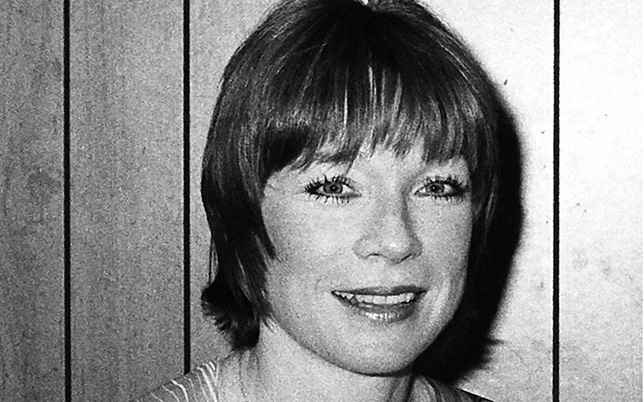
- Industry
Shirley MacLaine
Shirley MacLaine was born on April 24, 1934 in Richmond, Virginia. She had studied ballet from the age of 3 and moved to New York at 18 after graduating high school to perform in musical theatre on Broadway. That’s where Alfred Hitchcock saw her, as the understudy in The Pajama Game, and cast her in The Trouble with Harry (1954). Signed by producer Hal Wallis to a studio contract, she joined her childhood idols Dean Martin and Jerry Lewis in Artists and Models (1955). Interviewed by the journalists of the Hollywood Foreign Press in 1996, the actress who was named after Shirley Temple, explained how she and her younger brother Warren Beatty were motivated by their parents’ frustrations: “They failed at their own dreams and we lived the reaction to their failure; that’s why we’re both such over-achievers, we’re doing it for them. My mother (Kathlyn MacLean) was a dramatics teacher who was also an actress, my father (Ira Beaty) was a musician who wanted to run away and join the circus.”
In 1954 at age 20 MacLaine married Steve Parker, 12 years her senior; 2 years later they had a daughter, Sachi, who spent the first six years of her life on movie sets with her actress mother, until she was sent to school in Japan where her father was living, then to boarding schools in France and Switzerland from age 12. MacLaine admitted to HFPA: “As far as geographical nurturing with my daughter, I was away from her too much. But I saw my mother not do what she wanted, because she preferred to be working and expressing her creativity, instead she devoted her life to bringing up children. So I didn’t really want that. I have such admiration for women that can do both.”
MacLaine was brilliant in 1950s and 60s films, like Some Came Running (1958) by Vincent Minnelli with Frank Sinatra and Dean Martin, Ocean’s Eleven (1960), The Children’s Hour (1961) with Audrey Hepburn, directed by William Wyler from a play by Lillian Hellman, Two for the Seesaw (1962) by Robert Wise with Robert Mitchum, My Geisha (1962) with Ives Montand, The Apartment (1960) and Irma La Douce (1963) both directed by Billy Wilder co-starring Jack Lemmon, Gambit (1966) with Michael Caine, Sweet Charity (1969) by Bob Fosse. She joked: “During the first ten or fifteen years, I was the vulnerable doormat, then I got wise when my self-esteem rose.” In 1970 she published her first of many autobiographical books, Don’t Fall Off the Mountain, in 1972 she supported George McGovern’s presidential campaign, because she wanted to defeat Richard Nixon, in 1973 she travelled to China with a delegation of women to make the PBS documentary: The Other Half of the Sky: A China Memoir (1975). After all that time away, she realized she didn’t have a Hollywood career anymore, so she created her one-woman show for Las Vegas. She returned to films with The Turning Point (1977) by Herbert Ross, co-starring Anne Bancroft, about the life of ballet dancers, then made Being There (1979) by Hal Ashby with Peter Sellers.
MacLaine incorporated her experiences with politics, the feminist movement, foreign travels, New Age spirituality into her work as an actress in a changed Hollywood. She reflected to HFPA in 1976: “In the old days when you had the strong women characters played by Joan Crawford and Rosalind Russell and Bette Davis, after Katharine Hepburn and Spencer Tracy would fight it out, the woman still ended up in the arms of the hero in the third act. And you can’t do that necessarily anymore.”
In the 1980s and 90s MacLaine gave mature and varied performances in Terms of Endearment (1983) by James Brooks with Debra Winger and Jack Nicholson, Madame Sousatska (1988) by John Schlesinger, Steel Magnolias (1989) directed by Herbert Ross from a play by Robert Harling, with Olympia Dukakis, Sally Field, Julia Roberts, Daryl Hannah, Dolly Parton, Postcards from the Edge (1990) with Meryl Streep directed by Mike Nichols from a screenplay by Carrie Fisher, Used People (1992) by Beeban Kidron with Marcello Mastroianni, Wrestling Ernest Hemingway (1993) by Rhanda Haines with Robert Duvall and Richard Harris, Guarding Tess (1994) with Nicolas Cage. She talked to HFPA in 2008 about the directors she worked with: “The old creative geniuses of Hollywood ate, dreamt, slept with and lived for what their vision was; they were so insistent on their own vision being correct that nobody could talk them out of it, they were dictators on the set. But you had this sense of trust when you were working with William Wyler, Billy Wilder, Mike Nichols, Bob Fosse, Alfred Hitchcock.” The seasoned actress continues to work in her seventh decade in films like In Her Shoes (2005) by Curtis Hanson with Cameron Diaz, Bernie (2011) by Richard Linklater with Jack Black, The Secret Life of Walter Mitty (2013) by Ben Stiller. And she has just published another book, What If…: A Lifetime of Questions, Speculations, Reasonable Guesses, and a Few Things I Know for Sure. The Hollywood Foreign Press recognized Shirley MacLaine as New Star of the year in 1955 for The Trouble with Harry and as Most Versatile actress in 1959, with 4 Golden Globes as Best Actress for The Apartment in 1961, Irma La Douce in 1964, Terms of Endearment (1984), Madame Sousatska in 1989, the Cecil Be deMille award in 1998, and 14 nominations for Some Came Running (1959), Ask Any Girl (1960), The Children’s Hour (1962), Gambit (1967), Woman Times Seven (1968), Sweet Charity (1970), Being There (1980), Out On a Limb (TV-1988), Postcards from the Edge (1991), Used People (1993), Guarding Tess (1995), Hell On Heels (TV-2003), In Her Shoes (2006), Coco Chanel (TV-2009).